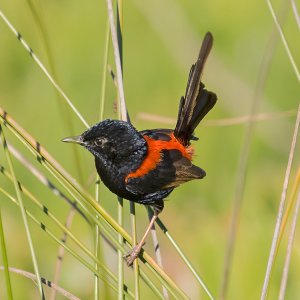You are here
Home ›Small Birds: A Call to Action
Our small Aussie birds are incredibly diverse; familiar faces include the Welcome Swallow, the New Holland Honeyeater and the Superb Fairy-wren. However, there are other, more secretive species that are being pushed out of our urban areas. Despite their beauty, resourcefulness and importance, small birds are declining across Australia. They are some of the most sensitive and affected birds to increasing levels of urbanisation and only 15% of all the species commonly found in cities weigh less than 15g. This contrasts with birds in native bushland, where around 40% weigh less than 15g. Despite this alarming trend, there are still actions you can take to support our small Aussie birds and encourage them back into our urban areas.
Bird-friendly Gardens
Small birds can be incredibly structure and resource sensitive, meaning that they require more complex vegetation to meet their needs. Birds such as the Scarlet Robin, Yellow-faced Honeyeater and Rufous Whistler require a well-structured shrub and mid-story layer for shelter, safety and resources. You can address this by creating a bird-friendly garden that provides the food, water, shelter and a place to nest that all birds need, especially the small ones.
Urban habitats are so fragmented that one garden will not be large enough to provide all the requirements that birds need. However, each garden is vital in forming the web of habitat that birds use. Take a 'birds-eye view' of your local area, including remnant bushlands, parks and open green spaces (check out Google Maps!). See how your garden connects to the surrounding habitat, each piece is vital for the birds that use it. We recognise that not everyone has access to a backyard that they can adapt into a bird haven so check out our tips on gardening in small spaces.
It is always a good idea to start with a solid foundation of knowledge on what birds are visiting your garden, what they need to thrive, and how you can adapt your garden to support them. Check out our guide on what you need to know before you get started.
Explore small bird diversity
You can learn about more of our small insect-eating bird with the Birds in Backyards Bird Finder tool. Take a look at the Grey Fantail, Satin Flycatcher and Yellow Thornbill who are canopy foragers that rely on insects to munch down on (and the occasional seed if you are a Thornbill). Small birds such as the Brown and White-throated Treecreeper and the Straited Pardalote rely on highly valuable and increasingly scarce tree hollows. The Stubble Quail, Red-backed Fairy-wren and the Australasian Pipit live amongst native grasses, shrubs and water sources to survive in more open habitats. You may also find the Little Grassbird and Australian Reed-Warbler in some of our urban wetland environments. There is an astounding array of small birds out there who play vital roles in our ecosystems and finding them all could occupy a lifetime!
Get Involved with Birds in Backyards
You can also take part in the Birds in Backyards Surveys. These surveys help the Urban Birds Program monitor changes in the distribution and abundance of either whole groups or individual birds that live where people live. In many cases we can relate these changes to the types of gardens that people own. This helps us deliver an appropriate research and education-based program to benefit both the people and birds living in our urban spaces. These surveys also help us address some of the most prominent threats facing small birds such as habitat loss, fragmentation, exotic plant species, competition and predation.
Lastly, one of the simplest and easiest steps to take is to educate yourself on the sheer diversity of Australian birdlife and to pass that knowledge onto others. The Birds in Backyards program offers a plethora of resources to help you on your urban bird journey and if you have any questions or need advice on how you can help our Australian bird life, you can contact us at birdsinbackyards@birdlife.org.au









